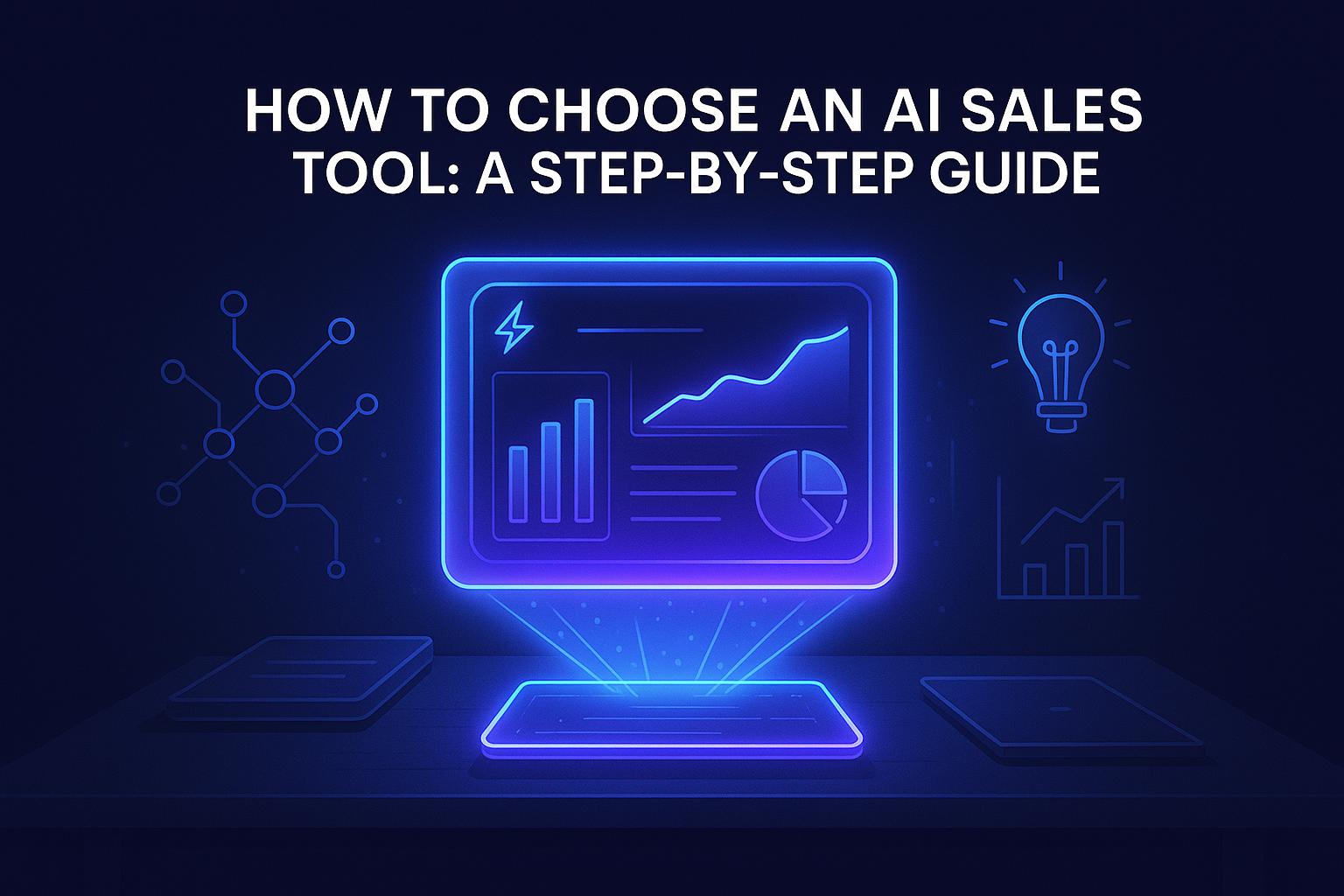AI tools are transforming sales processes across industries, delivering measurable results like 95% accuracy in forecasting and 35% revenue growth. Here's how businesses are benefiting:
- Sales Forecasting: Up to 95% accurate predictions.
- Lead Management: AI prioritizes the best prospects, improving conversion rates.
- Revenue Growth: Smart recommendations drive up to 35% more revenue.
- Efficiency Gains: Tasks like compliance checks are completed in hours, not days.
Quick Wins From AI Integration
- Healthcare: Improved lead qualification accuracy from 45% to 78%.
- Retail: Zara increased profit margins by 15% with dynamic pricing.
- Finance: American Express cut loan processing time from 7 days to 36 hours.
AI tools save time, reduce errors, and improve decision-making. To succeed, businesses must prepare their data, follow structured rollouts, and invest in training. Want to see results? Start small with a pilot program and scale up strategically.
Workflow Automation with AI and Zapier | CXOTalk #808
3 Industry Success Stories: AI Sales Integration
Here’s a closer look at how AI tools have transformed sales processes in healthcare, retail, and finance, achieving measurable outcomes through strategic use.
Healthcare Company Improves Lead Quality
A healthcare provider turned to an AI-powered scoring system to tackle inefficiencies in lead qualification, which had been dragging down conversion rates. By analyzing a variety of factors, the system brought clarity and precision to their sales process. Key data points included:
- Historical customer data
- Facility type and specialization
- Previous purchasing patterns
- Marketing engagement metrics
The results were striking:
- Lead qualification accuracy jumped from 45% to 78%.
- Sales cycles shortened by 35%.
- High-scored leads converted 4.2 times better than unscored leads.
- Sales reps managed 62% more qualified conversations each week.
- Customer acquisition costs dropped by 28%.
This healthcare provider’s success highlights how AI can refine lead management and drive better outcomes.
Retail Chain Optimizes Pricing
Zara, the global retail giant, leveraged AI for dynamic pricing and smarter inventory management. By integrating data from point-of-sale systems, inventory levels, loyalty programs, and competitor pricing, they streamlined operations and enhanced profitability. Within just six months, Zara achieved:
- A 15% increase in profit margins.
- A 22% boost in customer retention.
- A 30% reduction in excess inventory.
- Pricing adjustments completed in hours instead of days.
This approach not only improved operational efficiency but also strengthened Zara’s ability to respond quickly to market changes.
Bank Reduces Manual Sales Tasks
American Express used AI to automate time-consuming tasks like compliance checks and customer risk assessments - areas that previously consumed a significant portion of their sales team’s time. The improvements were dramatic:
| Process Area | Before AI | After AI |
|---|---|---|
| Compliance Verification | 2–3 days | 4 hours |
| Client Account Capacity | Base level | +60% |
| Loan Processing Time | 7 days | 36 hours |
| Documentation Errors | Base rate | –92% |
| Customer Satisfaction | Base score | +28% |
A senior executive remarked that automating these routine tasks allowed the team to focus more on relationship-building and addressing complex customer needs. This shift not only boosted performance but also enhanced customer satisfaction.
These examples show how AI, when thoughtfully implemented, can address specific challenges and unlock significant efficiencies across industries. By targeting pain points and deploying tailored solutions, these companies achieved transformative results.
How to Add AI to Sales Processes
Laying the groundwork is essential for successfully incorporating AI into sales workflows. These steps have been shown to deliver measurable results across a variety of industries.
Prepare Your CRM for AI Integration
The first step toward effective AI integration is ensuring your CRM system is ready. Research shows that companies that properly prepare their CRM systems can achieve up to a 30% boost in data quality.
Data Cleanup and Standardization
Before introducing AI tools, conduct a thorough data audit. This includes standardizing contact details, defining deal stages clearly, organizing custom fields, and ensuring consistent activity logging practices.
Infrastructure Updates
To support AI tools, many organizations enhance their CRM systems by adopting:
- Cloud-based solutions for scalability
- Strong API connectivity for seamless integration
- Reliable backup systems to prevent data loss
- Advanced security measures to protect sensitive information
Once your CRM is prepared, you can move on to integrating AI smoothly and effectively.
Step-by-Step Implementation Plan
With a prepared CRM, a structured plan can help streamline the AI integration process. Companies that follow a clear implementation strategy often see adoption rates increase by 65%.
| Phase | Duration | Key Activities | Success Metrics |
|---|---|---|---|
| Pilot Program | 4–6 weeks | Identify a test department, set benchmarks, and train users | Adoption levels, error reduction |
| Initial Rollout | 3 months | Gradual deployment, gather feedback, and refine systems | Productivity gains, data accuracy |
| Full Integration | 6 months | Company-wide rollout with advanced feature activation | ROI, customer satisfaction |
| Optimization | Ongoing | Regular updates, performance tracking, and team coaching | Efficiency improvements, revenue growth |
Training Strategy
Investing in tailored training programs can significantly improve AI tool adoption. Companies that focus on role-specific training report up to a 78% increase in utilization rates. Effective training methods include:
- Hands-on workshops for practical experience
- Self-paced online courses for flexibility
- Short, ongoing micro-learning sessions
- Internal "champions" programs to encourage peer learning
Performance Monitoring
Tracking the right metrics is crucial to measure success and refine your approach. Key indicators to monitor include:
- Increases in lead-to-opportunity conversion rates
- Reductions in sales cycle duration
- Revenue generated per salesperson
- Time saved on administrative tasks
Common AI Integration Problems and Solutions
When organizations bring AI sales tools into their workflow, they often face both technical hurdles and human challenges. Tackling these issues effectively is key to ensuring a smooth integration process.
Fix Data Connection Issues
AI thrives on high-quality, well-integrated data. But when data sources are fragmented or poorly connected, AI performance can suffer significantly.
Typical Data Challenges:
| Challenge | Effect | Solution |
|---|---|---|
| Data Silos | AI insights are limited due to isolated information | Use data integration platforms with API connectors to unify data sources |
| Format Inconsistencies | AI predictions may be inaccurate | Standardize data formats across all systems |
| Poor Data Quality | AI recommendations can be flawed | Deploy automated tools for data validation and cleaning |
To tackle these issues, companies often take a phased approach. For example, users of HubSpot Sales Hub successfully started by integrating core systems first, gradually adding other data sources into the mix. Similarly, Forecastio’s AI platform uses middleware solutions to solve integration challenges, achieving up to 95% forecasting accuracy.
Key Technical Requirements:
- End-to-end encryption to secure data
- Role-based access to protect sensitive information
- Regular system audits to ensure compliance
- API management tools for seamless connectivity
- Compatibility testing to avoid integration hiccups
While technical fixes are essential, addressing the human side of AI adoption is just as important.
Help Teams Accept New AI Tools
One common barrier to AI adoption is employee resistance, often driven by fears of being replaced. Organizations that succeed in AI integration focus on showing how these tools enhance, not replace, human efforts.
Strategies to Encourage Adoption:
-
Clear Communication
Highlight the benefits of AI tools. For instance, automation of repetitive tasks frees up employees to focus on more strategic and creative activities. -
Structured Training
A step-by-step learning program can ease the transition. Start with introductory sessions, move to hands-on workshops, and provide advanced training for key users. Regular feedback ensures that the training stays relevant and effective. -
Recognition Programs
Celebrate wins! Showcase how AI tools improve productivity, such as helping sales teams close deals faster or achieve better overall performance.
Security Considerations:
- Establish comprehensive data governance policies
- Conduct regular privacy impact assessments
- Draft clear agreements outlining data processing responsibilities
- Offer ongoing security awareness training to all employees
sbb-itb-3ed3a29
Track AI Tool Performance
Tracking how AI tools perform is crucial to confirm their impact and justify investments. By keeping an eye on both measurable outcomes and qualitative improvements, businesses can assess how AI influences sales and operations. These insights also support the success stories highlighted earlier.
Sales and Speed Improvements
Keeping tabs on sales performance can reveal how AI contributes to revenue growth and operational efficiency. For instance, one case study reported an impressive 95% forecasting accuracy thanks to better resource allocation. Similarly, Salesforce's use of Einstein AI within its CRM platform has been credited with boosting productivity, refining sales forecasts, and improving lead scoring. Across industries, AI has shown its value by speeding up deal closures and driving revenue growth. Beyond sales, tracking time savings and error reduction helps paint a fuller picture of AI's overall impact.
Time Saved and Error Reduction
AI excels at automating repetitive tasks, which not only saves time but also enhances data accuracy. Businesses can measure this by looking at reduced hours spent on tasks like data entry, administrative work, lead response, and report generation. This automation allows teams to focus on higher-value activities, improving overall efficiency.
Additionally, AI-driven systems minimize errors by ensuring consistent data entry and validation. By reducing inaccuracies, companies can make more reliable and informed decisions. AI-powered sales tools, for example, have demonstrated how better data validation can directly support smarter business strategies.
Performance Monitoring Best Practices:
- Regularly review metrics, especially during the initial rollout phase.
- Use dashboards to enable real-time tracking of key performance indicators.
- Compare current results with pre-AI benchmarks to measure progress.
- Fine-tune AI settings based on performance data for continuous improvement.
- Record both numerical achievements and qualitative feedback to capture the full scope of AI's impact.
Conclusion: Main Lessons from AI Success Cases
The examples above reveal clear patterns in how AI can drive measurable results. By implementing targeted AI solutions, companies achieved 30–40% improvements in key metrics within 6–9 months. Pairing these efforts with proper CRM integration also led to a 25% boost in adoption rates among sales teams.
Key Takeaways for Implementation
- Involving sales teams early increased user satisfaction by 40%.
- A phased rollout over 4–6 months reduced technical issues by 40%.
- Presenting AI as a "sales assistant" reduced resistance by 35%.
Successful strategies often included a structured timeline: 2–4 weeks for pilot programs, 1–2 months for departmental rollouts, and 2–3 months for full-scale deployment. On average, organizations allocated 15–20% of their sales tech budgets to AI, covering expenses like tools, integration, and training.
Maintaining high-quality data proved critical. Companies with 90%+ data accuracy, achieved through quarterly audits, saw 35% better AI performance. Additionally, gathering structured feedback every 60–90 days raised satisfaction levels by 40%.
The ROI metrics speak for themselves:
- Lead conversion rates climbed by 35–50%.
- Sales cycles shortened by 20–30%.
- Revenue per sales representative grew by an average of 27%.
- Top-performing teams achieved up to 95% accuracy in sales forecasts.
Ultimately, the most successful AI integrations stemmed from careful planning, regular monitoring, and a commitment to refining both technical and human elements. Companies that balanced these priorities saw the largest and most lasting improvements in their sales performance.
FAQs
What steps should a company take to prepare their CRM for AI integration?
To get your CRM ready for AI integration, the first step is to make sure your data is in great shape - clean, well-organized, and current. AI tools thrive on precise information, so it's crucial to eliminate duplicate entries and outdated records.
Once your data is sorted, take a closer look at your existing CRM setup. Pinpoint the areas where AI can make the biggest impact, whether that's improving lead scoring, refining sales forecasts, or enhancing customer segmentation. Collaborate with your team to define specific goals and what you hope to achieve with the integration.
Lastly, select AI tools that work seamlessly with your CRM system and match your business objectives. Before rolling it out completely, test the integration in a controlled environment. This step can help you spot potential issues early and ensure a smooth, disruption-free transition.
How can businesses address employee resistance to using AI tools in sales workflows?
How to Address Employee Resistance to AI Tools
Getting employees on board with AI tools starts with clear communication. Highlight how these tools can make their jobs easier by saving time, improving efficiency, and enhancing sales performance. When employees see AI as a way to simplify their work - not as a replacement - they're much more likely to embrace it.
Another key step is offering hands-on training and ongoing support. When team members feel confident in their ability to use these tools, their willingness to adopt them grows. Involving employees early in the selection process also helps. Giving them a voice fosters a sense of ownership and reduces skepticism.
Finally, don’t underestimate the power of celebrating small wins. Share success stories that show how AI tools have positively impacted sales outcomes. These examples can motivate others and demonstrate the real value AI brings to the team.
What key metrics can businesses track to measure the impact of AI tools on sales performance?
To assess how well AI tools are improving sales performance, businesses should keep an eye on key performance indicators (KPIs) that directly tie into their objectives. Here are some metrics worth tracking:
- Sales growth: Keep tabs on revenue or sales volume increases over a set timeframe to measure overall progress.
- Lead conversion rate: Calculate the percentage of leads turning into paying customers to gauge how effectively AI is driving conversions.
- Average deal size: Measure the average value of closed deals to understand if AI tools are helping identify higher-quality opportunities.
- Sales cycle length: Check if the time it takes to close deals is shrinking with the help of AI tools.
- Customer acquisition cost (CAC): Look at whether AI tools are making the process more efficient and reducing the cost of bringing in new customers.
By consistently analyzing these metrics, businesses can get a clear picture of how AI tools are streamlining their sales processes and delivering measurable outcomes.


